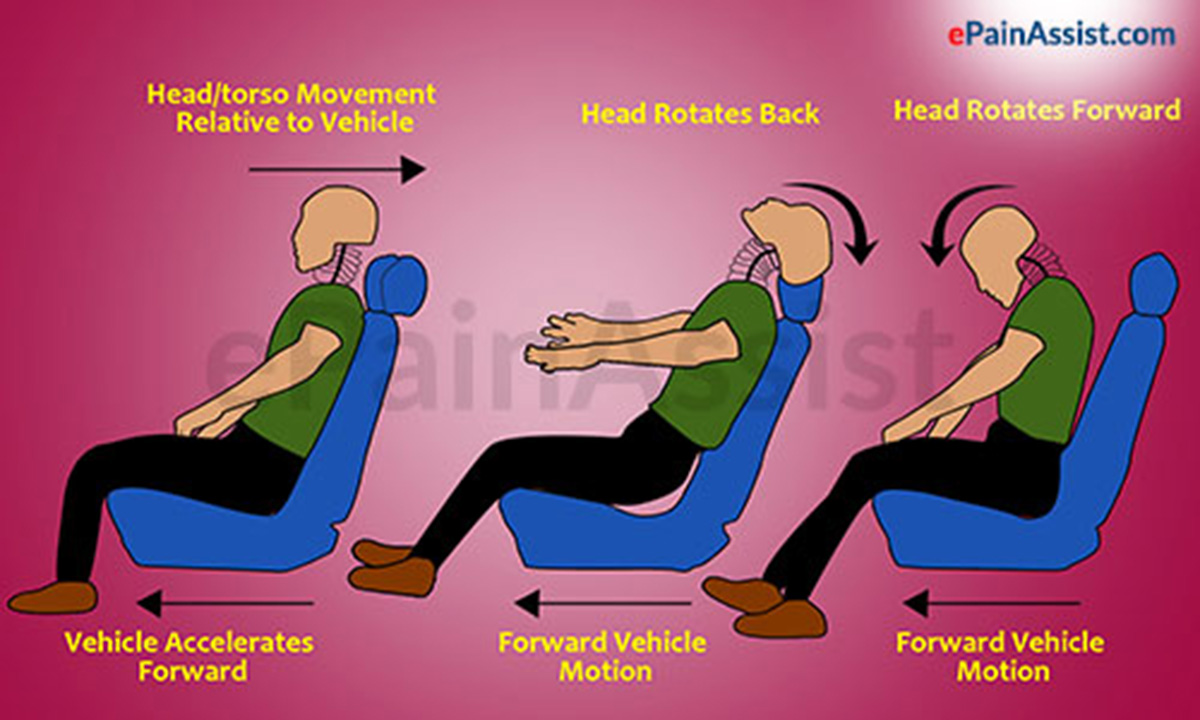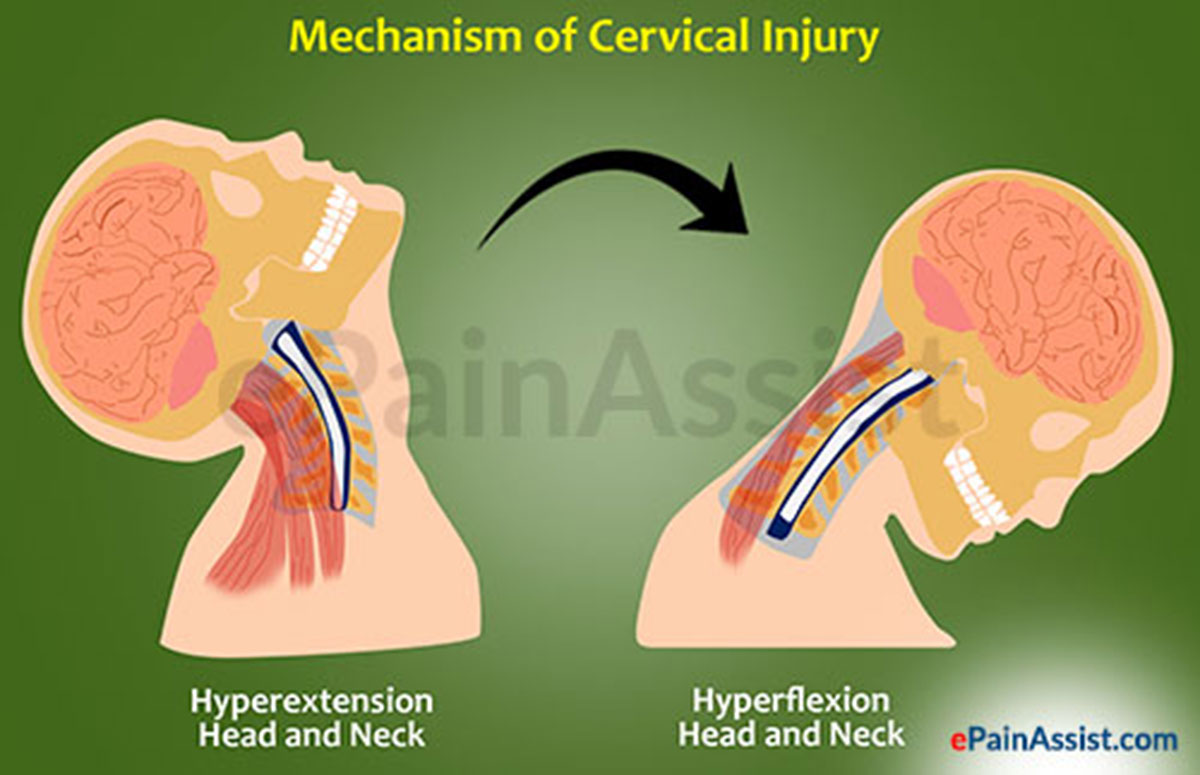What is a Whiplash Injury?
An abrupt acceleration and deceleration movement of upper and lower body causes whiplash injury to neck, lower back, jaw and extremities. Whiplash injury mostly involves neck and lower body following fall, automobile accident or work injuries. Change in velocity of body during fall or accident causes head, neck and lower body to move forward (hyperflexion) and backward (hyperextension) with jerk and force, resulting in whiplash injury.

What are The Common Injuries Following Whiplash?
Whiplash causes injuries of muscles, ligaments, joint, bones and intervertebral disc. Muscles and ligament may lacerate or tear and disc may bulge or herniate. Rarely joint dislocation or fracture of bones may follow severe whiplash injury.
Why Patients Often Have Severe Pain After Automobile Whiplash Injuries?
Incidence of fall, work accident or automobile accidents is often unexpected and instant. Such prevalence is traumatizing and disturbing. Whiplash injury produces plasticity of different neuronal structures within central (CNS) and peripheral nervous system. Plasticity of CNS results in amplification of nociception (pain stimulus) and leads to exaggerated pain responses.1 Central nervous system become hypersensitive to any sensory stimulation. Thus low intense nociceptive stimulation of peripheral tissue causes severe intractable pain in patients who had whiplash injuries.1
Does Fear Exaggerate Pain?
Studies published in the journal of “Pain”, indicates pain symptoms are exaggerated by fear.2 Study also suggest treatment of fear by exposure therapy had improved outcome of treatment.
Which Anatomical Part of The Body is Injured Following Whiplash Injury?
Whiplash injury causes trauma to neck, mandibular joint, lower back, ankle and foot. Study involving 6481 Saskatchewan residents suggest, 72% had headache and 60% had lumbar pain.3 Same study also indicates isolated neck pain is extremely rare. One year prospective study performed by Kasch H et al from department of Neurology, Denmark was published in 2003 involving 141 patients.4 This analysis suggest whiplash injury causes pain involving neck, head, shoulder, arm, and low back. Initial pain following whiplash injury is often presented with high frequency but low intensity of pain. Persistent symptoms of pain may be secondary to specific injuries and cognitive symptoms are secondary to nonspecific post-traumatic reactions.

How Soon Can One Recover After Whiplash Injury from Auto or Work Accident or Fall?
You may or may not have sustained a major injury following accident. Following accidental whiplash injury over 65% do not claim any pain or injuries. Since 1988 number of auto accident has reduced from 17.9 million a year to 10.8 million in 2009 was 0.5 Fatality rate observed in 2009 was 0.4 per 100 accidents with no-collisions and 1.4 deaths per 100 accidents following collisions.5 Most of the victims after moderate to severe whiplash injuries are upset and stunned. There is a chance you may be among 35% unfortunate patients, who may have sustained moderate to severe injuries after accident. Study published in 2008 by Holm L. W. et al affiliated with Division of Epidemiology of Karolinska Institution of Stockholm, Sweden suggest recovery following whiplash injury depends on patients expectation to get better.6 Study had enrolled 1032 patients following auto accident. Report indicates there is a link between expectations and disability among individuals with moderate disability.
Is It Possible to Predict Long-Term Disability Following Whiplash Injury?
No, whiplash injury following auto accident may cause trauma to soft tissue like muscles or tendons. Soft tissue injury results in severe pain during initial phase following whiplash injury. Patient may feel better in 4 to 6 weeks after treatment. Radiological studies may not show soft tissue or facet joint injury in majority of cases following trauma, and long term disability can not be predicted on the basis of results of these studies. Miettinen T. had published a retrospective study of 144 auto accident patients suggesting certain questionnaires can predict long term health problems.7
Can Whiplash Injuries Cause Disability?
Extensive soft tissue injury may heal with severe scar tissue. Scar tissue may cause severe neuropathic pain secondary to pinching of peripheral nerve. Intense continuous pain not responding to treatment may result in severe restriction of activities. Impairment and restrictions may lead to temporary or permanent disability. If patient had severe injury to facet joint, pain may continue for prolonged period and prognosis may not be good.8 Similarly, dislocation or fracture of bones in extremities or chest can cause prolonged pain and disability. Extensive injuries of neck and lower back when reported soon after the accident was significantly associated to a poor outcome in the follow-up.7
What Should I do After Whiplash Injury?
You should see a primary care physician or ER physician following whiplash injury. Following a detailed history and examination, you will be advised on taking blood examination and radiological studies like X-Ray, CAT scan or MRI.
Should There Be Activity Restrictions Following Whiplash Injury?
Restriction of activities depends on injuries. Most of the soft tissue and skeletal injuries are treated with conservative treatment involving medication and rest. Restrictions are short term or long term depending on injuries. Skin laceration, muscle and tendon injuries may be followed by short-term restrictions like 2 to 3 weeks. Dislocation or fracture may result in long-term restriction like 3 to 6 months. Long-term restriction following soft tissue injuries may cause tissue atrophy of the muscles and tendon resulting in anatomical impairment and disability.
Why is The Neck Most Common Anatomical Part to Suffer From Whiplash Injury in MVA?
Neck is the most vulnerable part of the body to get whiplash after automobile accident. Study of cervical spine kinematics in human model has provided date of biomechanical injuries of neck facet joint or Zygapophysial joints following automobile accident.9 Clinical studies have shown Zygapophysial joint injuries is more common following automobile accident.8
Is Compensation The Real Reason For People To Not to Get Better After Whiplash Injury?
No, a study published in Journal of Injury by Casey PP studied 246 people with whiplash injury. Outcome of study suggested helplessness was significantly associated with poorer reported health.10 Australian study by Spearing NM suggest following compensation or enforcing limits on compensation, patient is not cured.11
Whiplash Injury and The Quality Of Life Of the Injured
Injured victim following injury causing whiplash injury is often helpless because of impairment, disability, inability to pay bills, inability to take care of families, inability to pay medical bills and involved in dispute with insurance provider. Injuries following auto or work accident involves dispute between insurance provider and patients depending on cost and extent of treatment. Wrong signal may be triggered by a treating physician by performing too many test and procedures, or independent expert physician paid heavily to provide professional opinion regarding injury, outcome of treatment and prognosis.
- Sterling M, Hendrikz J, Kenardy J. Compensation claim lodgement and health outcome developmental trajectories following whiplash injury: A prospective study. Pain. 2010;150(1):22-28. doi:10.1016/j.pain.2010.02.021
- Linton SJ, Buer N, Vlaeyen JW, Hellsing AL. Are fear-avoidance beliefs related to the inception of an episode of back pain? A prospective study. Psychol Health. 2000;14(6):1051-1059. doi:10.1080/08870440008407363
- Cassidy JD, Carroll LJ, Côté P, Lemstra M, Berglund A, Nygren Å. Effect of eliminating compensation for pain and suffering on the outcome of insurance claims for whiplash injury. N Engl J Med. 2000;342(16):1179-1186. doi:10.1056/NEJM200004203421606
- Kasch H, Kongsted A, Qerama E, Bach FW, Bendix T, Jensen TS. A new stratified risk assessment tool for whiplash injuries developed from a prospective observational study. BMJ. 2005;330(7482):747. doi:10.1136/bmj.38314.608970.8F
- National Highway Traffic Safety Administration (NHTSA). Traffic safety facts. NHTSA; 2009.
- Holm LW, Carroll LJ, Cassidy JD, Skillgate E, Ahlbom A. Expectations for recovery important in the prognosis of whiplash injuries. PLoS Med. 2008;5(5):e105. doi:10.1371/journal.pmed.0050105
- Miettinen T, Airaksinen O, Lindgren KA, Leino E. Whiplash injuries in Finland: The situation 3 years later. Eur Spine J. 2001;10(5):398-402. doi:10.1007/s005860100318
- Lord SM, Barnsley L, Wallis BJ, Bogduk N. Chronic cervical zygapophysial joint pain after whiplash. A placebo-controlled prevalence study. Spine. 1996;21(15):1737-1745. doi:10.1097/00007632-199608010-00005
- Kumaresan S, Yoganandan N, Pintar FA, Larson SJ. Finite element analysis of the cervical spine: Role of the intervertebral disc in cervical spine biomechanics. J Biomech. 1999;32(7):673-679. doi:10.1016/s0021-9290(99)00054-4
- Casey PP, Feyer AM, Cameron ID. Course of recovery for whiplash associated disorders in a compensation setting. Injury. 2012;43(10):1678-1682. doi:10.1016/j.injury.2012.06.023
- Spearing NM, Connelly LB. Is compensation “bad for health”? A systematic meta-review. Injury. 2011;42(1):15-24. doi:10.1016/j.injury.2010.06.039
Watch What is Whiplash in 3D Video
Also Read:
